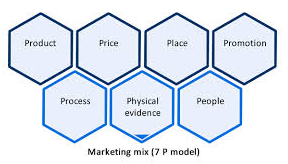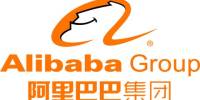The marketing mix is probably the most famous phrase in marketing. The elements are the marketing ‘tactics’. The marketing mix principles are controllable variables which have to be carefully managed and must meet the needs of the defined target group. All elements of the mix are linked and must support each other.
Marketing Mix on 7ps:

•Product
•Price
•Place
•Promotion
•People
•Process
• Physical evidence.
A product is seen as an item that satisfies what a consumer needs or wants. It is a tangible good or an intangible service. Intangible products are service based like the tourism industry, the hotel industry and the financial industry. Tangible products are those that have an independent physical existence. Typical examples of mass-produced, tangible objects are the motor car and the disposable razor. A less obvious but ubiquitous mass produced service is a computer operating system.
Every product is subject to a life-cycle including a growth phase followed by a maturity phase and finally an eventual period of decline as sales falls. Marketers must do careful research on how long the life cycle of the product they are marketing is likely to be and focus their attention on different challenges that arise as the product moves through each stage.
The marketer must also consider the product mix. Marketers can expand the current product mix by increasing a certain product line’s depth or by increasing the number of product lines. Marketers should consider how to position the product, how to exploit the brand, how to exploit the company’s resources and how to configure the product mix so that each product complements the other. The marketer must also consider product development strategies
Price –
The price is the amount a customer pays for the product. The price is very important as it determines the company’s profit and hence, survival. Adjusting the price has a profound impact on the marketing strategy, and depending on the price elasticity of the product, often; it will affect the demand and sales as well. The marketer should set a price that complements the other elements of the marketing mix.
When setting a price, the marketer must be aware of the customer perceived value for the product. Three basic pricing strategies are: market skimming pricing, marketing penetration pricing and neutral pricing. The ‘reference value’ (where the consumer refers to the prices of competing products) and the ‘differential value’ (the consumer’s view of this product’s attributes versus the attributes of other products) must be taken into account.
Promotion –
Promotion represents all of the methods of communication that a marketer may use to provide information to different parties about the product. Promotion comprises elements such as: advertising, public relations, personal selling and sales promotion.
Advertising covers any communication that is paid for, from cinema commercials, radio and Internet advertisements through print media and billboards. Public relations is where the communication is not directly paid for and includes press releases, sponsorship deals, exhibitions, conferences, seminars or trade fairs and events. Word-of-mouth is any apparently informal communication about the product by ordinary individuals, satisfied customers or people specifically engaged to create word of mouth momentum. Sales staff often plays an important role in word of mouth and public relations (see ‘product’ above).
Place –
Place refers to providing the product at a place which is convenient for consumers to access. Place is synonymous with distribution. Various strategies such as intensive distribution, selective distribution, exclusive distribution and franchising can be used by the marketer to complement the other aspects of the marketing mix
People-
An essential ingredient to any service provision is the use of appropriate staff and people. Recruiting the right staff and training them appropriately in the delivery of their service is essential if the organisation wants to obtain a form of competitive advantage. Consumers make judgments and deliver perceptions of the service based on the employees they interact with. Staff should have the appropriate interpersonal skills, aptititude, and service knowledge to provide the service that consumers are paying for. Many British organisations aim to apply for the Investors In People accreditation, which tells consumers that staff are taken care off by the company and they are trained to certain standards.
Refers to the systems used to assist the organization in delivering the service. Imagine you walk into Burger King and you order a Whopper Meal and you get it delivered within 2 minutes. What was the process that allowed you to obtain an efficient service delivery Banks that send out Credit Cards automatically when their customers old one has expired again require an efficient process to identify expiry dates and renewal. An efficient service that replaces old credit cards will foster consumer loyalty and confidence in the company.
Physical Evidence-
Where is the service being delivered? Physical Evidence is the element of the service mix which allows the consumer again to make judgments on the organization. If you walk into a restaurant your expectations are of a clean, friendly environment. On an aircraft if you travel first class you expect enough room to be able to laydown!
Physical evidence is an essential ingredient of the service mix, consumers will make perceptions based on their sight of the service provision which will have an impact on the organizations perceptual plan of the service.
















